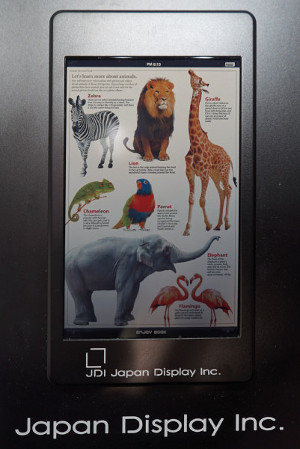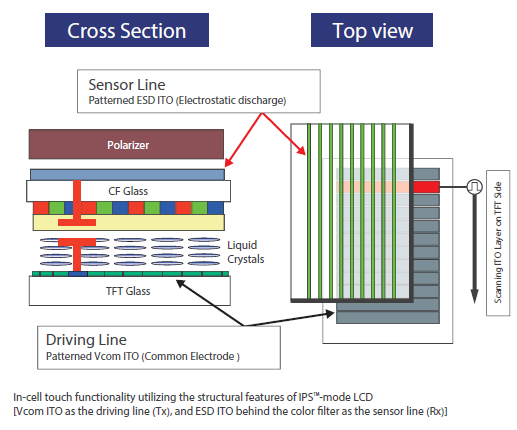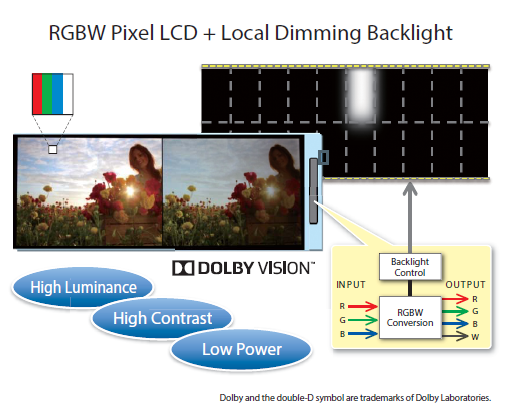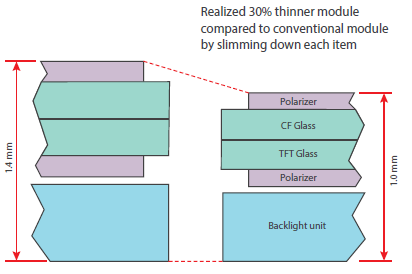I’d be tempted to say that the sheer number of things that JDI showed us was the highlight of the booth, but several of the demos were also very impressive.
We started by looking at the JDI Memory in Pixel (MIP) technology (a concept which was also being shown by Sharp and AUO). JDI had three demos of a 1.3″ round 218 x 218, a 0.99″ round 180 x 186 and a 1.39″ 205 x 148 panel all of which had 182ppi. Gamut was quoted at 30% and typical power at <40μW allowing for very long display times. There was also a 1.34″ 238ppi version that also had an analogue mode to allow video display video when power goes up from 10mW for still images to 20mW for video.
The next display we looked at was probably the best reflective LCD we have seen. Although gamut was quoted at just 30% of NTSC, and bit depth at just 6 bits colour, it looked very good. The resolution is 1920 x 1200, which gives 321ppi (which probably helps the colour by effectively spatially dithering – Man. Ed.). Reflectance was quoted to us at 21%, which is high. JDI’ transflective display looked very good
JDI’ transflective display looked very good
Next we looked at a new prototype autostereo display that uses head tracking to modify an “active barrier” to create the 3D. JDI claims that the tracking system completely eliminates some objectionable artefacts of the AS3D.
Automotive was the next topic and like several other vendors, JDI had a 12.3″ 1920 x 720 cluster display. The panel uses JDI’s IPS Neo technology to deliver better contrast and viewing angles and which is based on exploiting UV alignment technology, which JDI started to supply in July last year. IPS Neo can be supplied on many different sizes and types of displays. There was also a 3.1″ HUD display with 800 x 480 resolution and the IPS Neo (normally black) LC mode.
A key point for JDI is its in-cell touch display that it calls Pixel Eyes. Toshiba claims s/n immunity and impressed us by showing its use with a passive stylus – something that another exhibitor had told us was “impossible with in-cell touch”. Sorry, guys, JDI does it very well. We looked at an 8″ display and a 10.00 display with 2880 x 1080 resolution, which gives 308ppi and has 1,500:1 contrast. The 10″ was curved at a 500mm radius. There was also a 3.1″ 800 x 480 (297ppi) HUD display.

JDI’s Steve Vrablik told us that he had heard that eliminating the big mirrors used by trucks can mean as much as a 5% saving in fuel consumption and that will drive truck makers to bring them inboard.
Temperature ranges have been increasing and JDI has developed a new LC mixture for IPS mode that can dramatically improve response times in low temperatures – for example around 50ms at just above -25ºC from around 180ms in a conventional display. This kind of performance is also important in applications such as DSC viewfinders as well as in automotive.
We were impressed with the next demonstration which showed one of JDI’s “White Magic” RGBW technology fitted with local dimming. The 10″ display was edge-lit from top and bottom with each side having ten zones, so that there are twenty zones in total. The system uses Dolby Vision technology, the first time we have seen this in mobile applications.

As well as improving the dynamic range, the technique saves power. Black level is a big point for auto makers who want the display to disappear when not in use and JDI has Pixel Eyes direct lamination technology that improves black levels. A 7″ FullHD White Magic display boosts brightness from 530 cd/m² with RGB pixels to 980 cd/m². Contrast is 1,800:1.
Turning to mobile applications, we were impressed with a 5″ FullHD LCD that is just 1mm thick and is already in mass production. The slim design is achieved by slimming down each layer of the display.

Next, we looked at a new 5.2″ FullHD display that boosts gamut from the standard sRGB gamut up to 92% of NTSC. This is achieved by using RG LEDs (white LEDs made with a blue emitter and red and green phosphor rather than the YAG phosphor of traditional white LEDs) and optimised colour filters. A 5.5″ display with in-cell touch is already in mass production and there are seven variations between 4.7″ and 5.7″ and between 294ppi and 534ppi.
A technology demo of an 8″ panel with UltraHD had 95% of NTSC and 2000:1 contrast and there was also a 10.1″ landscape UltraHD panel (348ppi) with 400cd/m² and 1100:1 contrast. Gamut is 71% of NTSC. The 8″ can use a passive stylus.
![]()
The industrial monitor of JDI operates as KOE and that group is in the middle of a three phase expansion. It has back end module assembly and can support rudggedisation, optical bonding, wide temperature operation and the addition of procap touch. It supports up to 17″ as standard, but can also offer 19″ and 21.3″ displays.
We looked at the developments. It seems that JDI is collaborating with JOLED and will make the smaller displays for mobile applications, while JOLED makes bigger displays.
There was a demonstration 5.2″ FullHD OLED with 423 ppi and made on a plastic substrate with LTPS transistors. It can be curved and was made using white OLED with colour filters. Thickness is <0.05mm and the pixel structure is based on WhiteMagic RGBW.
Finally we looked at the medical panels. The 5 megapixel monochrome mammography LCD now uses Neo IPS for 1500:1 contrast and an LED backlight for 1,000cd/m² of brightness. The 3 megapixel colour panel has the same specifications and technologies.
Phew!

